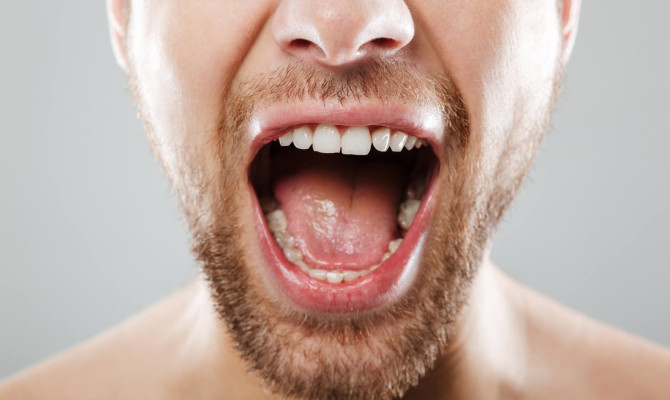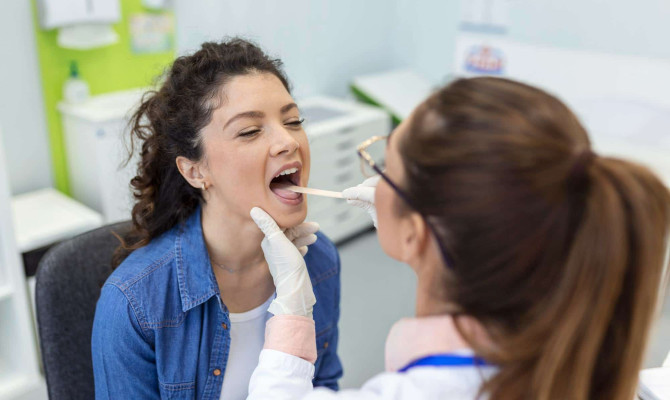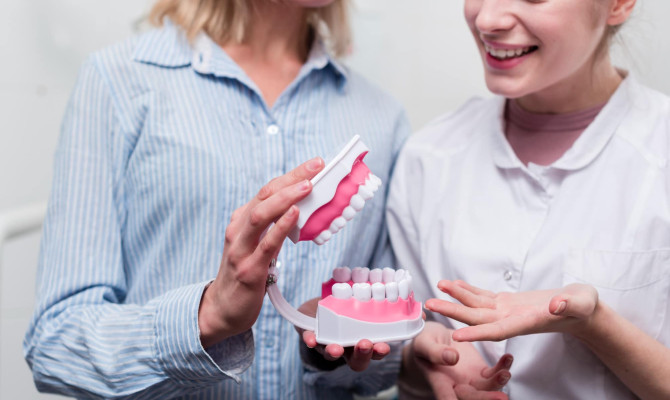Black Spot On Gums: Is it Normal?

- Gums
- 15 Sep 2023
Introduction
Black Spot on Gums
Any unexpected changes can raise worries because our dental health is a window into how we are as a whole. The appearance of black patches on gums is among the many dental oddities people may experience. These can have a variety of origins, ranging from minor pigmentation abnormalities to potential signs of underlying issues. In this article, we’ll delve into dental health to uncover the root causes of black spots on gums, providing insight into potentially harmless diseases and circumstances requiring medical intervention.

Understanding its nature enables us to make informed decisions about our oral care, regardless of whether it is merely a simple occurrence of natural pigmentation or an indication that necessitates a dentist consultation. Any variations from the norm in our dental health demand our attention because it is a portal to our general well-being. The formation of black spots on gum is unusual among the fascinating everyday occurrences. 1 Introduction | Researched based study from National Institutes of Health
Importance
Understanding the importance of oral health
- Gum health is crucial for maintaining the overall health of the mouth.
- It is essential because these soft tissues protect dental roots, support teeth, and assist in holding teeth firmly in place. They also add to our visual attractiveness.
- They are health indicators that have been compared to a barometer for our general health. Gum texture, color, or appearance changes can be early indicators of possible health problems.
- The emergence of black spots on gums becomes noteworthy at this point since they can indicate various underlying factors.
Causes

Causes of Black Gums
- Genetics
- Ethnicity
- Hormone changes
- Sun exposure
- Age
- Amalgam tattoo
- Oral trauma
- Embedded foreign particles or debris
- Serious medical conditions
Depending on the individual’s genetics and cultural background, it can range from pale pink to different colors of brown. Here are some reasons for pigmentation listed below:
Genetic factors
- The color of our gums can reveal the amount of melanin present in our skin and gums at birth.
Ethnicity
- The degrees of melanin synthesis in various ethnic groups produce distinctive skin tones.
Hormone changes
- Hormonal changes, such as those that occur during pregnancy, can cause momentary changes in the color of the gums.
Sun exposure
- Sunlight has a similar impact on skin pigmentation as it does on gum color. Too much sun exposure could make gum tissue darker.
Age
- It can change over time. Melanin levels may change as we age, changing the color of our gums. 1 Causes| Researched based study from National Institutes of Health , 2 Causes | Researched based study from National Institutes of Health
Amalgam tattoo
- Sometimes, when amalgam fillings are used in dentaltreatments, minute pieces are embedded in the gum tissue. Localized discoloration, often known as an amalgam tattoo, may result from this.
- Notably, in particular, during the removal or placement of amalgam fillings. These pieces may eventually create a definite blue or black stain on the gums.
- Despite their nature, amalgam tattoos are mostly harmless and do not need to be treated unless they are unsightly.
Melanin deposits
- Rise in melanin naturally. It can build up in the gum tissues and cause black stains on skin, skin color, hair, and eyes.
- Although usually harmless, some activities might warrant additional investigation. These cells occasionally become more active in specific regions, resulting in darker patches or spots.
Oral trauma and blood blisters
- A minor lesion to the gums or developing blood blisters due to an injury might cause transient black spots. As the injured tissue heals, these patches should disappear.
- Blood blisters or hematomas can arise from blood vessels rupturing due to accidental biting or injury during dental operations.
- On the gums, these can look like black or dark patches. Blood blisters are typically transient and will go away when the wounded tissue heals, even though they may be unsettling.
- Their recovery process may be aided by maintaining good oral hygiene and avoiding additional trauma.
Particles with foreign and debris embedded
- They may develop due to a foreign object or trash stuck in the tissue. Small amounts of food, splinters, and other things can be among them. 2Causes | Researched based study from National Institutes of Health , 3 Causes | Researched based study from National Institutes of Health ,5 Causes | Researched based study from National Institutes of Health
Potential concerns: Oral pathology
Other warning symptoms of oral cancer
- Even though it’s uncommon, several types of oral cancer might appear as black spots or strange gum discoloration. In such situations, additional comorbid symptoms and risk factors should be considered. 2 Causes | Researched based study from National Institutes of Health ,3 Causes | Researched based study from National Institutes of Health
Warning Signs
Warning signs for Black Spots on Gums
Even while many black spots on the gums are unimportant, there are several circumstances in which caution is required. This section will address the differences between benign marks and alterations needing more attention and oral melanoma’s uncommon but with deadly potential. We will also discuss warning signals for various types of mouth cancer.
Oral Melanoma
- It is an uncommon and severe oral cancer that can affect the gums and other parts of the mouth.
- The black spot is unevenly formed, asymmetrical, or has uneven boundaries.
- The site has evolved, either in size, shape, or color. There is bleeding ulceration, along with all the pain that it causes.
Oral melanotic macula
- This disorder, also known as localized melanosis, manifests as a flat region of increased pigmentation on the mucous membrane of the mouth, including the gums. 4 Warning Signs | Researched based study from National Institutes of Health
- Typically, small and benign, these patches present no health danger. They are frequently innocuous unless they produce cosmetic issues and don’t require treatment.
Peutz-Jeghers syndrome
- In addition to melanin spots on the lips and inside the mouth, this rare hereditary condition is characterized by the growth of hamartomatous polyps in the gastrointestinal tract.
- These stains may occur on mucous membranes such as the gums. It needs medical management and is linked to an elevated risk of specific health problems.
Addison’s disease
- It is an ailment that affects the adrenal glands and causes insufficient hormone production.
- Increased pigmentation in numerous body areas, including the gums, might be one of the signs. This often involves more significant, widespread regions rather than isolated locations.
Associated hyperpigmentation with smoking
- Localized hyperpigmentation, notably on the gums, can result in the mouth.
- Dark patches or spots may appear as a result. These alterations can get better if you give up smoking.
Hyperpigmentation caused by minocycline
- It is an antibiotic that can cause the oral tissues, among other tissues, to become greyish-blue in color.
- Once you stop taking the medicine, this is frequently reversible.
Melanoma
- Melanoma, albeit rarely, can develop in the mouth and the gums. It is a specific type of cancer that develops from melanocytes producing melanin.
- It may appear on the gums or other oral tissues as black spots or patches. For positive results, early detection and treatment are essential.
Pigmentation brought on by medication
- As a side effect, some drugs might cause changes in oral pigmentation. 3 Warning Signs | Researched based study from National Institutes of Health , 1 Warning Signs | Researched based study from National Institutes of Health , 2 Warning Signs | Researched based study from National Institutes of Health
Differentiating harmless spots from alarming ones
Vigilance is needed to distinguish between harmless spots and alterations that call for alarm. Important factors include:
Duration
- On stem two of the melanin deposit, areas resembling amalgam tattoos continue to exist over time with little change. Unsettling developments could emerge quickly.
- Most of the time, they do not result in pain, discomfort, or bleeding. Any accompanying symptoms can suggest that more testing is required.
Consistency
- They frequently look the same. Unusual forms, sizes, or color codes point to a more significant problem.
- Seeking a professional opinion is essential when there is doubt or concern. 1 Warning Signs | Researched based study from National Institutes of Health , 2 Warning Signs | Researched based study from National Institutes of Health
Diagnosis
Diagnosing Black Spot on Gums
A methodical diagnostic technique is necessary to correctly identify the issue’s origin and choose the best action. Getting advice on spots and consulting a dentist or other oral healthcare professionals when treating black spots is crucial. They are qualified to evaluate oral health issues and distinguish between benign variations in pigmentation and more severe diseases.
Medical history and a visual examination
- The first stage of the diagnostic author’s process entails a visual examination of issues by the author. Dental experts will closely examine the size, shape, texture, and color.
- They will also enquire about the patient’s medical background, lifestyle choices, and any pertinent symptoms. This thorough method aids in creating an initial impression and eliminating potential causes.
Advanced diagnostic methods and biopsies
- Dentists frequently advise a biopsy or other diagnostic tests when there is uncertainty or the possibility for issues to develop to get more information.
- It involves removing a tiny tissue sample from the afflicted area for laboratory analysis. This can assist in identifying the cellular makeup and excluding other illnesses like oral melanoma or mouth cancer.
Additional advanced diagnostic methods include
Dermatoscopy
- Dermatoscopy includes looking at skin and mucosal regions using a specialized tool to expose hidden features, similar to using a magnifying glass-rays, CT scans, or MRIs may be employed.
Imaging studies
- To evaluate the degree of tissue involvement and rule out any underlying diseases imaging tests may be employed.
- X-rays, CT scans, or MRIs may be employed for amalgam tattoos.
Treatment
Treatment for Black Spot on Gums
Managing and treating benign pigmentation
- No treatment may be required if it is confirmed that the black patches are the product of harmless pigmentation differences.
- These activities might be a healthy, natural component of your oral pigmentation. However, maintaining good dental hygiene habits and routine checking are still advised.
Removal of dirt or foreign materials
- Professionals may advise cautious removal of the foreign particles, debris, or splinters that are causing the dark spots in the tissue. Moving these items can ease pain and reduce the risk of infection. 6 Treatment | Researched based study from National Institutes of Health
Prevention
Preventing Black Spot on Gums
Preventing the development of black spots and other dental problems can be considerably aided by taking proactive measures to maintain good gum health.
Keeping up good hygiene
- Effective oral hygiene practices must be followed consistently to prevent various oral problems. Plaque can cause gum issues, so brushing your teeth with fluoride toothpaste daily can help eliminate it.
- Remember to gently brush your gums to encourage blood flow and gum health. The health of your gums can be significantly impacted by style and lifestyle variables.
- Being aware of them can help prevent problems that could result in discolorations.
Use of nicotine
- Smoking and other tobacco use can reduce the amount of blood that reaches the gums, which increases the risk of gum disease and tooth stains.
Diet
- Gum health is supported by a balanced diet full of vitamins and minerals.
- For example, consuming enough vitamin C is crucial to keeping healthy gums.
Sun safety
- The oral tissues may be affected by prolonged sun exposure. They can be protected by using lip balm with sun protection or by limiting their exposure to the sun.
Routine dental examinations
- Regular dental exams can be essential for preserving gum health and avoiding problems.
- Early indications of gum disease, changes in skin color, and other conditions can be recognized by dental specialists.
- Additionally, routine checkups offer the chance for professional cleaning, which eliminates plaque and tartar that may contribute to gum disease.
Self-examination
- Self-examination is crucial in addition to professional dental examinations. Give Inspector Gums a quick visual inspection.
- Watch for any adjustments in texture or color. Consult your dentist right away for additional testing if you observe anything out of the ordinary. 7 Prevention | Researched based study from American Dental Association
FAQs
Black Spot on Gums-Frequently Asked Questions
What do healthy gums look like?
- They are often coral or pink in color. However, naturally brighter or darker gums are common.
Size and form
- Each tooth should be entirely and uniformly sealed off by it. They shouldn’t look inflated, too puffy, or like they’ve retracted.
Consistency
- They shouldn’t bleed when your teeth, when you leave skin, or when you eat. Gum disease may be present if your gums bleed readily.
- There is no fading. A healthy gun should not have dark stains, patches, or other strange discolorations.
No sensitivity or pain
- They shouldn’t cause harm or make you uncomfortable.
- Absence of inflammation or swelling
- Healthy gums shouldn’t be red or inflamed.
Is black gum serious?
- They may have several underlying reasons, and the precise cause determines their significance. Although many black gum cases may not be substantial, checking them out is necessary to identify the cause.
When should I see a dentist about black spots on my gums?
- It is advised to make an appointment with a dental specialist for the evaluation if you observe any changes in your gums’ color or texture or if you feel any discomfort, pain, or strange symptoms.
Is it normal for my gums to change color as I age?
- Yes, it can change over time due to various reasons and changes in melanin production brought on by aging.
The Bottom Line
Black Spot on Gums – Get a dental opinion
You can proactively address problems and priorities for your oral health by providing yourself with knowledge. For management measures, it is crucial to correctly diagnose the cause of the black spots by speaking with a dental expert. Gum health can be supported by practicing proper oral hygiene and shielding your gums from the sun. It’s important to communicate openly with your dentist. Share any changes you see in your gums so your care can be individualized and considered during the diagnostic procedure. You may actively contribute to maintaining your general health by making informed decisions regarding your dental health.
Any feedback on this article?
 This Articles content was accurate
This Articles content was accurate Very Informative Article
Very Informative Article I have a question or a comment
I have a question or a comment
 This article contains inaccurate content
This article contains inaccurate content This article was not helpful
This article was not helpful I have a question or a comment
I have a question or a comment
We appreciate your helpful feedback!
Checkout our social pages
References
-
National Institutes of Health
Introduction | Causes | Warning Signs
-
National Institutes of Health
Causes | Warning Signs
-
National Institutes of Health
Causes | Warning Signs
-
National Institutes of Health
Warning Signs
-
National Institutes of Health
Causes
-
National Institutes of Health
Treatment
-
American Dental Association
Prevention



































